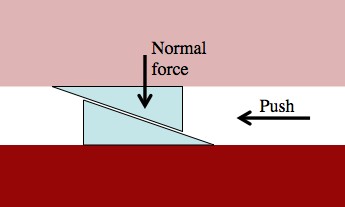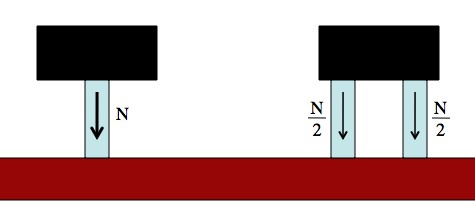Physicist: Political conversations with family, for one.
“Friction” is a blanket term to cover all of the wide variety of effects that make it difficult for one surface to slide past another.
There a some chemical bonds (glue is an extreme example), there are electrical effects (like van der waals), and then there are effects from simple physical barriers. A pair of rough surfaces will have more friction than a pair of smooth surfaces, because the “peaks” of one surface can fall into the “valleys” of the other, meaning that to keep moving either something needs to break, or the surfaces would need to push apart briefly.
This can be used in hand-wavy arguments for why friction is proportional to the normal force pressing surfaces together. It’s not terribly intuitive why, but it turns out that the minimum amount of force, Ff, needed to push surfaces past each other (needed to overcome the “friction force”) is proportional to the force, N, pressing those surfaces together. In fact this is how the coefficient of friction, μ, is defined: Ff = μN.

The force required to push this bump “up hill” is proportional to the normal force. This is more or less the justification behind where the friction equation comes from.
The rougher the surfaces the more often “hills” will have to push over each other, and the steeper those hills will be. For most practical purposes friction is caused by the physical roughness of the surfaces involved. However, even if you make a surface perfectly smooth there’s still some friction. If that weren’t the case, then very smooth things would feel kinda oily (some do actually).
Sheets of glass tend to be very nearly perfectly smooth (down to the level of molecules), and most of the friction to be found with glass comes from the subtle electrostatic properties of the glass and the surface that’s in contact with it. But why is that friction force also proportional to the normal force? Well… everything’s approximately linear over small enough forces/distances/times. That’s how physics is done!
That may sound like an excuse, but that’s only because it is.
Q: It intuitively feels like the friction force should be directly proportional to the surface area between materials, yet this is never considered in any practical analysis or application. What’s going on here?
A: The total lack of consideration of surface area is an artifact of the way friction is usually considered. Greater surface area does mean greater friction, but it also means that the normal force is more spread out, and less force is going through any particular region of the surface. These effects happen to balance out.
Pillars are just a cute way of talking about surface area in a controlled way. The same argument applies to surfaces in general.
Q: If polishing surfaces decreases friction, then why does polishing metal surfaces make them fuse together?
A: Polishing two metal surfaces until they can fuse has to do with giving them both more opportunities to fuse (more of their surfaces can directly contact each other without “peaks and valleys” to deal with), and polishing also helps remove impurities and oxidized material. For example, if you want to weld two old pieces of iron together you need to get all of the rust off first. Pure iron can be welded together, but iron oxide (rust) can’t. Gold is an extreme example of this. Cleaned and polished gold doesn’t even need to be heated, you can just slap two pieces together and they’ll fuse together.
Inertia welders also need smooth surfaces so that the friction from point to point will be constant (you really don’t want anything to catch suddenly, or everyone nearby is in trouble). This isn’t important to the question; it’s just that inertia welders are awesome.
Q: Why does friction convert kinetic energy into heat?
A: The very short answer is “entropy”. Friction involves, at the lowest level, a bunch of atoms interacting and bumping into each other. Unless that bumping somehow perfectly reverses itself, then one atom will bump into the next, which will bump into the next, which will bump into the next, etc.
And that’s essentially what heat is. So the movement of one surface over another causes the atoms in each to get knocked about jiggle. That loss of energy to heat is what causes the surfaces to slow down and stop.








I may be wrong, but wouldn’t the normal force in the first picture be perpendicular to the friction surface?
That picture is supposed to be an extreme close-up. Should have made that remotely clear.
It was perfectly clear to me.
I am experimenting with a Chinese Spouting Water Bowl. I notice that when you rub the handles with only fingers or with tiny hands the bowl vibration make a higher pitched sound. Is there a relationship between the surface area or friction and higher pitched vibrations?
when we observe a surface under a powerful microscope , we find that there are irregularities on it. Even a smoothing has a large number of irregularities. These irregularities get interlocked when one object tries to move over another this is oppose the moionof body trying to move and give rise to friction
got it*
Ummmmmm. I just wanted to know the variables…..